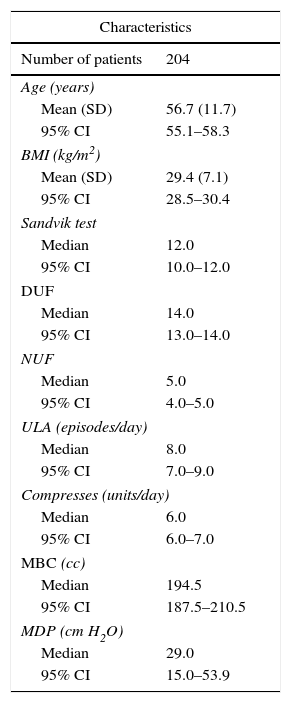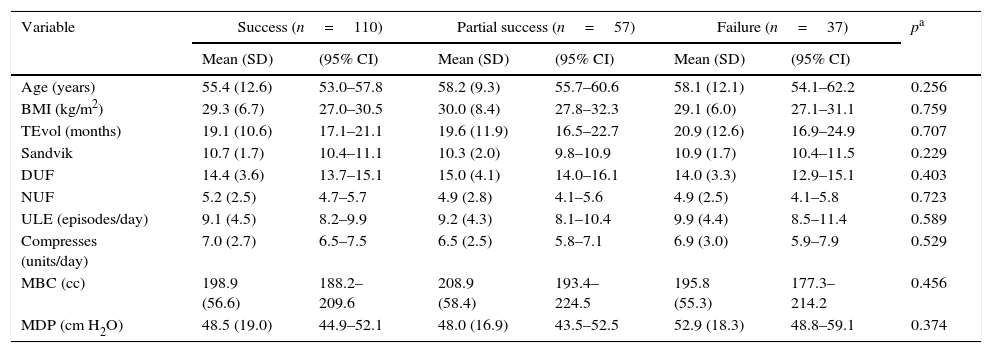To assess the safety and efficacy of a single intravesical injection of onabotulinumtoxinA (OnaBTA) for treating urge urinary incontinence (UUI) in women.
MethodWe performed a prospective case-series study of consecutive patients with refractory UUI treated with an intravesical injection of OnaBTA. The patients were administered 100 units of OnaBTA injected into the bladder wall following 4 weeks of flushing with anticholinergic agents or beta-3 agonists. The urodynamic and clinical endpoints were evaluated before and 6 months after the injection of OnaBTA. The primary study endpoint was the number of episodes of urinary leakage.
ResultsA total of 204 of the 210 selected patients conducted a valid visit 6 months after the therapeutic application. At 6 months of treatment with OnaBTA, 110 (53.9%) patients remained continent and were considered a success. However, 57 (27.9%) patients experienced one episode of urinary leakage per day, and 37 (18.2%) had 2 or more. In terms of the urodynamic parameters, we observed the following changes: increase in maximum bladder capacity (p<0.0001) and reduced maximum pressure of the detrusor (p<0.0001). In terms of the safety profile, 8 (3.9%) patients had self-limiting haematuria during the procedure, which resolved spontaneously, and 9 (4.4%) patients had acute urinary retention that required intermittent catheterisation.
ConclusionsThis study supports the use of OnabotulinumtoxinA in patients with urge urinary incontinence that does not respond to medical treatment.
Evaluar la eficacia y seguridad de una inyección intravesical única de Onabotulinumtoxin A (OnaBTA) en el tratamiento de la incontinencia urinaria de urgencia en mujeres.
MétodoSe realizó un estudio prospectivo de serie de casos en pacientes consecutivas con incontinencia urinaria de esfuerzo refractaria tratadas con una inyección intravesical de OnaBTA. Las pacientes recibieron 100 unidades de OnaBTA inyectada en la pared vesical después de 4 semanas de lavado de anticolinérgicos o agonistas beta 3. Las variables urodinámicas y clínicas fueron evaluadas antes y 6 meses después de la inyección de OnaBTA. La variable principal del estudio fue el número de episodios de escapes urinarios.
ResultadosUn total de 204 de las 210 pacientes seleccionadas realizaron una visita válida al sexto mes de la aplicación terapéutica. A los 6 meses del tratamiento con OnaBTA 110 (53,9%) pacientes permanecieron continentes y fueron consideradas como éxito. Por otro lado, 57 (27,9%) presentaron un episodio de escape urinario por día y 37 (18,2%) tuvieron 2 o más. En relación con los parámetros urodinámicos se observaron los siguientes cambios: aumento de la capacidad vesical máxima (p<0,0001) y disminución de la presión del detrusor máxima (p<0,0001). En cuanto al perfil de seguridad, 8 (3,9%) pacientes tuvieron hematuria autolimitada durante el procedimiento, que se resolvió espontáneamente; 9 (4,4%) pacientes tuvieron una retención urinaria aguda que precisó cateterización intermitente.
ConclusionesEste estudio apoya el uso de onabotulinumtoxin A en pacientes con incontinencia urinaria de urgencia que no responden al tratamiento médico.









